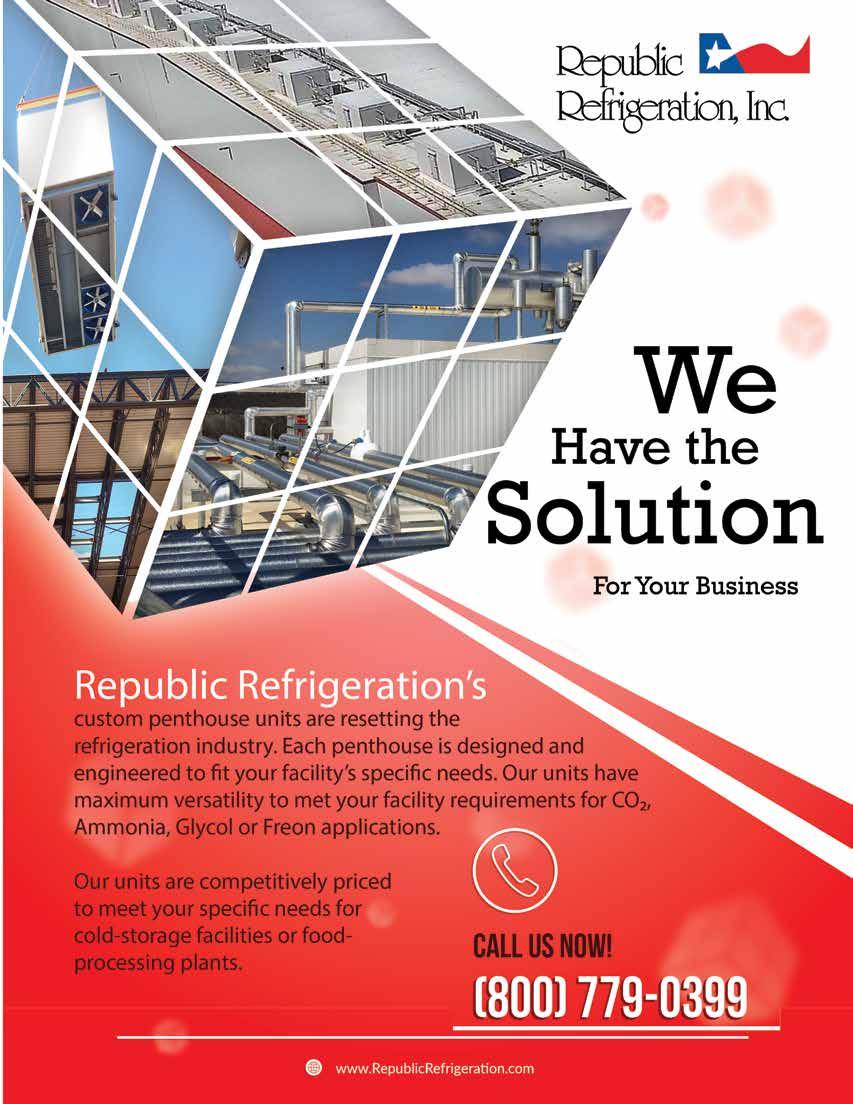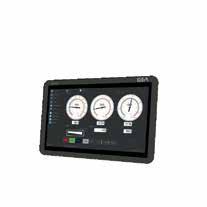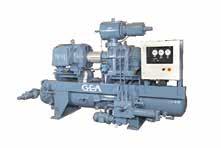
13 minute read
Is an ammonia refrigeration
(f) An indication whether one or more of the following has occurred:
(1) fire (2) explosion (3) death (4) serious injury (5) property damage
(g) The name of the material(s)involved in the accidental release, the Chemical Abstract Service (CAS) number(s), or other appropriate identifiers
(h) If known, the amount of the release
(i) If known, the number of fatalities
(j) If known, the number of serious injuries
(k) Estimated property damage at or outside the stationary source
(l) Whether the accidental release has resulted in an evacuation order impacting members of the general public and others, and, if known:
(1) the number of persons evacuated (2) approximate radius of the evacuation zone (3) the type of person subject to the evacuation order (i.e., employees, members of the general public, or both) making reports to the NRC “immediately” after knowledge of a reportable incident.
If the owner or operator has not submitted a report to the NRC and notified the CSB
the owner/operator must submit a report directly to the CSB within eight hours of the accidental release.
ENFORCEMENT The Final Rule states that the CSB’s focus will be on education and compliance, not on “creating traps for the unwary”. However, the rule does make it unlawful for any person to fail to make reports required under the regulation. Suspected violations of the regulation will be forwarded to the EPA for possible enforcement action, which could include administrative penalties, civil
Reports may be made by email to: report@csb.gov, or by telephone at 202- 261-7600.
WHAT IF YOU ALREADY REPORTED TO THE NRC? The Final Rule recognizes that in some cases a facility is already required to make a report to the NRC within a specified timeframe. In order to minimize duplication, the Final Rule states that if the owner or operator has submitted a report to the NRC the CSB reporting requirement may be satisfied by submitting the NRC identification number to the CSB within 30 minutes of submitting a report to the NRC. This is the most likely scenario for IIAR members, as the industrial refrigeration industry is already accustomed to actions, or criminal actions. To allow adequate time for compliance education, CSB will provide a one-year grace period. The CSB has indicated that it looks forward to working with owner/ operators and other stakeholders to help ensure compliance.
Moving forward, it is important for IIAR members to understand that they are now responsible for notifying the CSB of reportable incidents. In most cases, this will likely take the form of providing the CSB the NRC identification number within 30 minutes of contacting the NRC. However, there may be cases where facilities need to make a full report directly to the CSB. Members are encouraged to familiarize themselves with the regulation and be prepared to meet the new requirements.

Is an Ammonia Refrigeration Evaporative Condenser a PermitRequired Confined Space (PRCS)?
BRYAN HAYWOOD
his article will explore the questions so many have regarding their evaporative condensers and OSHA’s PermitRequired Confined Space standard(s) (29 CFR 1910.146 and 29 CFR 1926.1201 - .1213).
We will look at the two most common models/designs: 1) Forced Draft (fans are vertical and on the bottom section) T
2) Induced Draft (fans are horizontal and on the top section)
Although both condenser designs will share an atmosphere between the top and bottom sections, depending on the model at your facility, the top and bottom sections most likely will need separate evaluations done because the physical hazards in these sections and the results may be different. For example, the lower section of an induced draft condenser may only be a “confined space”, where the upper fan maintenance section is without a doubt a “permitrequired confined space”, because of the proximity to fan blades and power transmission devices. This is important to point out, because most condensers will in fact have two (2) spaces within the unit; each one needing its own evaluation and possibly its own labeling based on the outcome of the evaluation(s). First things first, what makes an evaporative condenser a “confined space” (CS)?
In the USA, we use OSHA’s criteria that any space that meets ALL THREE (3) of the following is defined as a Confined Space: 1) Is large enough and so configured that an employee can bodily enter and perform assigned work; AND
2) Has limited or restricted means for entry or exit; AND
Are condenser’s “large enough and so configured that an employee can bodily enter and perform assigned work”? YES. Workers “bodily enter” (i.e. fully enter) this equipment for maintenance activities and once inside, have no problems moving around to do their assigned tasks.
In fact, many manufacturers are making their units easier to bodily enter and perform assigned work by making their entry portals larger. (More on these “larger openings” later)
Most forced- draft models have entry portals on both ends of the lower fan section, but once through the entry portal (i.e. manway) these models are quite “roomy” regarding confined space size standards.
In induced draft models that have top fans, the fan access area can be a tight squeeze to work in, but the space is actually provided by the manufacturer to bodily enter and perform assigned work on the fan and its power transmission devices. So clearly these spaces are large enough and so configured that an employee can bodily enter and perform assigned work.
Do condensers have “limited or restricted means for entry or exit”? YES. Even with the two (or more) openings, ALL the entry/exit portals on all models I have ever seen pose a LIMITED OR RESTRICTED means of entry or exit! I like to say…
“Any opening that we have to slide/ slither/crawl/climb/contort through is a “limited means of entry or egress” REGARDLESS of how many of these types of openings there are to enter or exit the space”.
We can literally have dozens of openings of which we can slide/slither/crawl/ climb/contort through and the number of openings means absolutely nothing – it is the size of those openings that matters.
Since this “limited or restricted means for entry or exit” characteristic seems to be causing a lot of confusion due to some marketing/sales literature from some manufacturers, I thought it would be prudent to share OSHA’s official position (since 1995) on how the phrase “limited or restricted means for entry or exit” is defined within the agency’s OSHA Instruction CPL 2.100:
A space has limited or restricted means of entry or exit if an entrant’s ability to escape in an emergency would be hindered. The dimensions of a door and its location are factors in determining whether an entrant can easily escape; however, the presence of a door does not in and of itself mean that the space is not a confined space. For example, a space such as a bag house or crawl space that has a door leading into it, but also has pipes, conduits, ducts, or equipment or materials that an employee would be required to crawl over or under or squeeze around in order to escape, has limited or restricted means of exit. A piece of equipment with an access door, such as a conveyor feed, a drying oven, or a paint spray enclosure, will also be considered to have restricted means of entry or exit if an employee has to crawl to gain access to his or her intended work location. Similarly, an access door or portal which is too small to allow an employee to walk upright and unimpeded through it will be considered to restrict an employee’s ability to escape. OSHA published a technical amendment to the preamble in Federal Register / Vol. 59, No. 213 / Friday, November 4, 1994, page 55208. (emphasis by me – NOT by OSHA)
Basically, for an entry/exit portal to NOT limit or restrict the means for entry or exit, the portal would need to be a FULL-SIZE door so the entrant could literally walk into the space as if he/she were walking into an office. And even
with this full size door, the space may still pose “limited or restricted means for entry or exit” due to the configuration of the space and equipment, such as piping, conveyors, and baffles, within the space. So, with all that said, most evaporative condensers will have limited or restricted means for entry or exit. Are condensers “designed for continuous employee occupancy”?
NO. Evaporative Condensers are designed to have water cascading down over refrigerant coils and have fan blades moving large volumes of air thru the unit. There is NO WAY any rational person can argue this space was “designed for continuous employee occupancy”. Offices, lunchrooms, training rooms, process production rooms and etc. are “designed for continuous employee occupancy” - NOT evaporative condensers.
We cannot confuse “maintenance access portals” provided by a manufacturer with the phrase “designed for continuous employee occupancy “. Just because a manufacturer provides a means to enter their condenser (as they all do), this in no way alluding that the space is “designed for continuous employee occupancy”. This debate regarding condensers is quite easy, because most manufacturers have placed DANGER signs at their entry portals telling the entrant that hazards are present behind the entry portal cover. If the space behind the cover was in fact “designed for continuous employee occupancy” there would be no hazards within the space and no need to place DANGER/CAUTION/WARNING signs at the portal(s). So, we have a space, an evaporative condenser, that: 1) is NOT designed for continuous employee occupancy, AND
2) has limited or restricted means for entry or exit, AND 3) is large enough and so configured that an employee can bodily enter and perform assigned work The results of our assessment tell us our evaporative condenser is a CONFINED SPACE.
But strictly in the terms of OSHA compliance, 29 CFR 1910.146 and
Peak performance, low cost, ready for tomorrow’s demands... Right out of the box.
Visit us at the 2020 IIAR Conference Booth No. 601

Agility ™ Refrigeration Equipment Controllers
• Meets or exceeds efficiency and safety standards • Installs with simple field configuration via web browser • Scales from single item to system-wide control • Integrates with any control system • Leverages decades of Logix controls experience
PRODUCT SOLUTIONS
Agility
Evaporator Condenser Vessel Mechanical Room NH3 Ventilation Emergency Pressure Control
logix-controls.com 425.828.4149 10518 NE 68th St., Ste. 103, Kirkland, WA 90833
1926.1201-.1213 do NOT apply to spaces that are determined to be merely a “confined space”. For these OSHA standards to apply to the space, the space must have a permit-required confined space (PRCS) hazard.
OSHA defines a PRCS as a “confined space” that has at least one (1) or more of the following hazard(s): 1) Contains or has a potential to contain a hazardous atmosphere; OR 2) Contains a material that has the potential for engulfing an entrant; OR ated by inwardly converging walls or by a floor which slopes downward and tapers to a smaller cross-section Please understand that I have never managed treated or untreated condenser water cascading down into a basin that is knee-deep as an “engulfment hazard”. I keep hearing arguments put forth that the condenser water is “treated” with some hazardous chemicals and therefore “treated water” should be considered a “hazard”. Folks, I will never tell anyone who feels like something is a hazard to
3) Has an internal configuration such that an entrant could be trapped or asphyxiated by inwardly converging walls or by a floor which slopes downward and tapers to a smaller cross-section; OR 4) Contains any other recognized serious safety or health hazard.
For the sake of time and space, I will not break down each of these four (4) categories of PRCS hazards because OSHA has done a nice job within both standards AND because we really only need to discuss two (2) of the hazard categories. Leaving out, for now, the discussion regarding the ammonia in the coils during entry, I do NOT believe condensers have: 1) a material that has the potential for engulfing an entrant, NOR do they have 2) an internal configuration such that an entrant could be trapped or asphyxinot respect their feelings; however, if we truly believe our “treated water” is indeed a “hazardous chemical/material” we will need to take the following steps just to meet OSHA minimum safety standards regarding hazardous materials: 1) obtain or develop a SDS for this “treated water”, 2) ensure our condenser basins and feed tanks are properly labeled with appropriate hazard labels to reflect the hazard(s) of the “treated water”, and 3) label our “treated water” lines/piping per ASME A13.1, Scheme for the Identification of Piping Systems I have yet to find anyone who has claimed their “treated water” is hazardous and has taken any of these steps mentioned above to properly manage their “treated water” as a hazardous chemical/material as spelled out in 29 CFR 1910.1200. But I digress – feel free to manage your “treated water” as a “hazard” but it will NOT be an “engulfment hazard” in the vast majority of condensers due to the design, size, and configuration of most condenser basins. HOWEVER, condensers do contain a “recognized serious safety or health hazard” because once we have entered, either the upper fan section on the induced draft models or the lower fan section on the forced draft models, we are exposed to UNGUARDED FAN BLADES and POWER TRANSMISSION DEVICE(s). These mechanical hazards make these spaces within the condenser a PRCS.
Now it’s time to discuss the 800-pound gorilla in the room and that is ammonia in the coils during entry. The main question is: Do we have to evacuate the NH3 from the condenser coils before our entry? Well it looks like we have run out of time and space, so tune into the next “Condenser” edition for the answer. But I can give you a hint… It depends on which entry method we want to use in our entry: 1910.146(c)(5) or 1926.1203(e) - Alternative Entry 1910.146(c)(7) or 1926.1203(g) - Reclassification 1910.146(d)-(k) or 1926.1204 - 1926.1211 – FULL “permitted-entry” It is also worth noting that if the work taking place within the permitrequired confined space is installation work (i.e. construction work), then the facility AND the contractor will need to follow Subpart AA (Confined Spaces in Construction) 1926.1201 - .1213 rather than 1910.146 requirements.
The entry method will dictate entry requirements (e.g. rescue available vs. not having to have rescue available). But until then, I would suggest evacuating the NH3, properly isolating the NH3 using one of the three (3) acceptable isolation means, and reclassifying your condenser to a NONPRCS- unless, of course, the facility has mastered sections 1910.146(d) - (k) or 1926.1204 - .1213 and can meet at least the OSHA minimums related to “permitted-entries”.
the optimal cold service system
04
03
02


01
01
02
03
04
The optimal Cold Service System starts with RG-2400 ® gel on the pipe to prevent corrosion.
VaporGuard™ for use as a vapor stop on sub-freezing insulation systems.
Dow ® Styrofoam ™ insulation provides long-term stable R values.
The insulation is covered with Polyguard ZeroPerm ® or Insulrap ™ vapor retarders to keep the insulation dry. Or complete the system with our Alumaguard ® family of flexible weatherproof cladding products.

for a World of Applications Industrial Refrigeration Solutions
Compressor packages, controls, chillers, and more
GEA’s robust lineup of solutions features screw and reciprocating compressor packages spanning 60 to 6083 CFM, each paired with the industry-leading GEA Omni™ control panel. Our expertise also extends to chillers, custom-engineered systems, service support and training. Talk with us to learn why quality-driven contractors and end users worldwide choose GEA and how we can meet your process-critical cooling requirements.


GEA North America: 717 767 6411 | sales.unitedstates@gea.com










